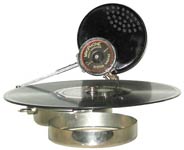
|
Deutscher Text Mit dem "Mikiphone" kam 1926 ein wahres Wunderwerk auf den Markt. Als Sinnbild von Genfer Uhrmacherkunst und Erfahrung der Grammophon-Hersteller aus dem Waadtländer Jura, stellt es eine Art Synthese von höchster Präzision und industrieller Tradition dar. Es waren die aus Ungarn stammenden Gebrüder Nicolas und Etienne Vadàsz, die in Genf 1924 ihre Erfindung zum Patent anmeldeten. Mit der Firma Paillard & Cie aus Ste-Croix wurde ein Partner gefunden, der bereit war das Gerät in die Serienproduktion aufzunehmen. Nach einigen technischen Pannen lief die Fabrikation auf Hochtouren. Die Gebrüder Vadàsz hatten jedoch Schwierigkeiten, die vereinbarten 10 000 Stück pro Monat abzusetzen. Deshalb drosselte man die Produktion auf 3000 Stück pro Monat, ehe sie 1927 eingestellt wurde. Insgesamt wurden rund 180 000 "Mikiphone" hergestellt, wovon es eine kleine Serie in der Luxusvariante mit versilbertem oder vergoldetem Gehäuse gab. Das Gerät mit einem Durchmesser von 11,5 cm hat die Grösse
einer Käseschachtel. Als Klangverstärker dient ein sogenannter
Resonator aus schwarzem Bakelit. Wegen der kleinen Dimension des
Plattentellers mit einem Durchmesser von 10 cm muss die Schallplatte
an der Mittelachse befestigt werden. Alle Teile sind derart geschickt
angefertigt, dass sie problemlos in der Metalldose versorgt werden
können.
|
English Text The Swiss-made "Mikiphone" is probably the smallest talking machine ever placed on the marked, folded up to the size of a large pocket watch or a small cheese case. As a symbol of the art of watch making from Geneva and the tradition of gramophone manufacturers in the country side region of the Swiss Jura mountains, this gramophone is something like a wonder work. It was in November 1924 as the "Mikiphone" was patented by the Vadász brothers from Geneva. Later, there was signed contracts with the Paillard company from Ste-Croix to produce this talking machine. After some initial problems, the production runs at full speed. But the Vadász brothers was in troubles with this arrangement, to distribute 10’000 pieces per month. Paillard reduces the production at 3’000 pieces each month but also this quantity was to high. So in 1927 the production was cancelled. Total there was produced some 180’000 "Mikiphone", from all of them a few in a luxury version with golden or silver case for a pretentious clientele. The closed "Mikiphone" resemble a cheese-box. It plays
Records of up to 10 inches or 25 cm. The arrangement of the packing
is ingenious with the turntable having holes to accept parts of
the sound box whose diaphragm is not on the usual side. The resonator,
which is used in place of a horn, is in two pieces witch fit concave
to concave sides. Due to the small size of the turntable a spring
clamp is supplied the records in place. |
